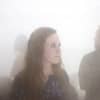Brian Roettinger is a graphic designer and friend and collaborator of No Age. He also has a thing for balled up paper. That's basically what you need to know about before you delve into Oliver Rivard's interview with Roettinger, about his Soundscreen book, which is accompanied by a 10-inch record of original music by No Age. Check a one-minute sample of the music and the interview after the jump. And pick up the book right here.
Stream: One-minute No Age sample
What's up with your book?
It first started as a sort of case study. I wanted to use it as a case study for ideas, using it really as a journal. In doing so, I was making these collages by crumpling paper and then xeroxing it as a sort of study to get new collages—a new way to collage just by crumpling paper. It's purely a formal technique. But just by crumpling paper, and xeroxing it, rather than in traditional collage, where you take elements and build upon and layer. So I was letting the crumpling of the paper do the collaging with itself. In that sense, I did about, I don't know, 500 of them and I actually started tearing one page out of every book that I owned and did one. I was going to have one from every book that I owned. That was one idea, but that's not what this one was. This one was done with just one magazine: an old issue of Fortune 500 from the ’60s. There was no meaning to that other than compositions in magazine with the type and the image were kind of... They used different typefaces then and the photography was different and scale was different so when became these sort of collages, in a way, they looked way different than what you would get from contemporary paper.
They're definitely pretty to look at, which I would not have immediately assumed. It must have taken a lot of strategy and careful selection in order to pull that off.
Definitely. You look at them all, and I kind of chose them like a yearbook. The ones that felt different and looked different. A lot of them, you're just like, they all look good but some look similar. Then I would start to pair them and then make pages out of them, almost like an index. I created an index with them and used them as if they were like these portraits. And then that became the sort of study for the book. And then in the end, what it did, it became a jumping-off point for what the new No Age record is. We were all dealing with these same ideas of starting from scratch, or getting something that was old and starting something that was new. Kind of like re-skinning yourself, or transcending. Then that sort of related to this idea of crumpling paper too and getting rid of the old, perhaps, or shedding skin in a way. The index of them all was like letting go of these old things and that became the jumping off point for the No Age record. We like that as a sort of language and essentially that became the cover, one of these. You can sort of tell there is a definite similarity.
Would you say that that's how you would explain this piece's connection to music, that it exemplifies the feeling out of which the No Age album was conceived? What does the record included in the back have to do with all that?
Well, the relationship that images have to the music is purely a formal one.
In what sense?
When we made the songs and did the tracks, we would use pre-recorded material, or sample sounds, and it kind or became these layered collages. And in many ways that's a similarity to the collages, like using a preexisting printed page. It's pretty literal in that sense, but essentially we wanted the record to be a sort of soundtrack to the book, in any way possible. So if someone wanted to look at this they could listen to the song at the same time and have their own interpretations of how they relate or don't relate. But there was no sense that there was a direct relationship, like, these images mean this in relationship to the music.
It's interesting that you're talking so much about collage and re-appropriation or sampling of objects, because all the Artist Music Journals frame the artwork on the pages. They're all intentionally made to look like photographs of the pieces, as if they were artifacts in a museum or works in a gallery. Your edition definitely has this same quality, but that's not a style I think most people would expect from you, as a designer. When I think of your work, I think of illustration and minimal, geometric typeface design, not pictures of objects.
Yeah, a lot of the design work that I do actually relies heavily on photography, and I think a lot of the pieces in this book are these sort of typographic collages in a way. So there are similarities there. Some of them are these sort of minimal, abstract forms. Less geometric because there's less precision there. It's interesting that you say that because I think I rely so much on things being precise and geometric, obviously I'm interested in geometry and elements of that, so I think that with this, it was kind of nice to be a little bit more loose. It was a study.

